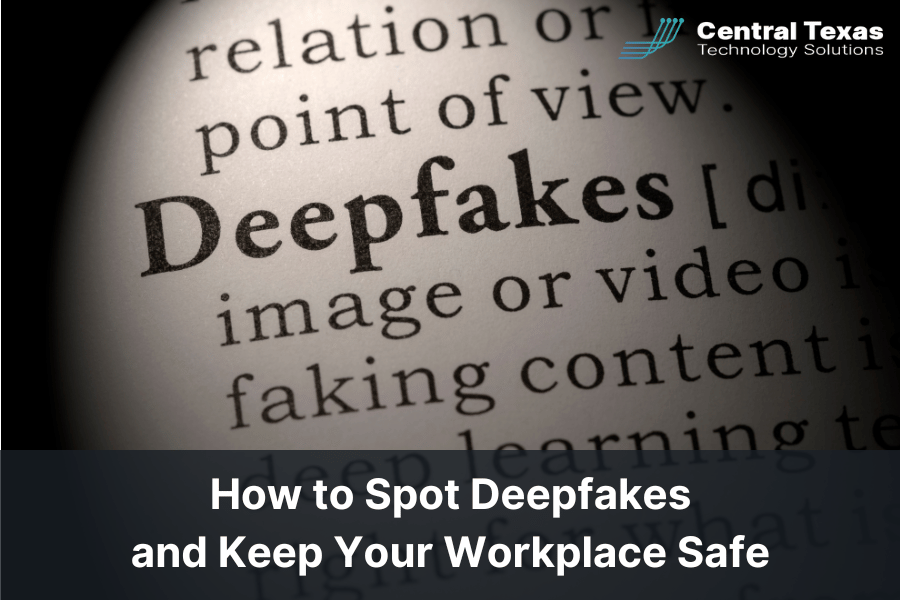
Imagine this: you get a call from your CEO asking you to wire a large sum of money to a foreign bank account. It seems unusual, but the voice is unmistakably theirs. You comply, only to discover later that it wasn’t your CEO on the other end of the line but a cybercriminal using deepfake technology to impersonate them. This isn’t a plot from a sci-fi movie - it actually happened to a bank employee. This incident is just one example of how deepfakes can deceive even the most vigilant among us.
Deepfakes, AI-generated content designed to mimic real people convincingly, are quickly becoming a significant cybersecurity threat. Combating deepfakes and protecting workplaces from digital deception requires a mix of advanced security technologies and employee preparedness. In this article, we’ll explore the dangers of deepfakes and practical strategies to keep your business safe.
What Are Deepfakes and Why Should Businesses Care?
A deepfake is a type of synthetic media created using artificial intelligence to replace a real person’s likeness and voice convincingly in videos, images, or audio. While the technology behind deepfakes has the potential for legitimate uses, cybercriminals have weaponized it to commit fraud, manipulate public perception, and breach corporate security.
Why deepfakes are a serious threat:
- Impersonation attacks: Cybercriminals can mimic company leaders to authorize fraudulent transactions or extract sensitive information.
- Reputational damage: Fake videos or statements can spread rapidly, causing significant brand harm.
- Manipulation of crisis responses: Deepfakes can be used to release fake statements during crises, leading to misinformed decisions.
According to Deloitte, over 90% of all data breaches start with phishing attacks. Deepfakes elevate this threat by making deceptive communications nearly indistinguishable from legitimate ones.
How to Spot Deepfakes: Key Warning Signs
As deepfakes become more sophisticated, detecting them requires a keen eye and some technical know-how. Here are some practical tips to help your team identify potential deepfakes:
- Video cues:
- Blurred edges or inconsistent lighting
- Unnatural facial movements or expressions
- Odd eye or mouth movements
- Audio cues:
- Mismatched lip-syncing or unnatural pauses
- Robotic speech patterns or strange intonations
- Background noise that doesn’t match the scene
- Contextual cues:
- Unusual requests, especially involving financial transactions
- Urgent or threatening language designed to provoke a quick response
- Requests that bypass standard protocols or processes
Encourage employees to trust their instincts—if something feels off, it’s worth a second look.
Strengthening Workplace Security Against Deepfakes
Combating deepfakes and protecting workplaces from digital deception demands a combination of cutting-edge technology and vigilant employees. Here’s how to enhance your defenses:
1. Invest in AI-Based Detection Tools
Since AI creates deepfakes, it can also help detect them. Security tools powered by machine learning can analyze audio, video, and text for signs of manipulation. Investing in these tools can help your business:
- Identify mismatches in lip-sync and audio tone.
- Detect irregularities in video compression or lighting.
- Flag unusual behavior in email and communication channels.
2. Enhance Identity Verification Protocols
Traditional passwords are no match for deepfakes. Advanced multi-factor authentication (MFA) methods can significantly reduce the risk of deepfake-driven breaches:
- Biometric verification: Fingerprints, voice recognition, or facial scans.
- Behavioral analysis: Typing speed, mouse movements, or interaction patterns.
- Time-sensitive PIN codes: One-time use codes sent to a verified device.
These methods make it more challenging for hackers to use deepfakes to bypass security checks.
3. Train Employees to Recognize Deepfakes
Awareness is your first line of defense. Regular training sessions should cover:
- Understanding deepfake technology: How it works and why it’s a threat.
- Spotting red flags: The warning signs of deepfake content.
- Verification protocols: Encouraging employees to follow up on unusual requests through trusted channels.
Interactive training exercises, such as simulated phishing attacks and deepfake detection challenges, can prepare employees for real-world scenarios.
The Role of AI in Combating Deepfakes
AI isn’t just a threat—it’s also a powerful tool for defense. Emerging AI solutions can:
- Analyze voice patterns: Detect slight deviations in pitch and cadence.
- Examine metadata: Identify irregularities in video and audio files.
- Leverage blockchain: Authenticate the origin and integrity of digital content.
Combining AI tools with employee vigilance creates a robust defense against digital deception.
The Bottom Line: Stay Vigilant and Informed
Deepfakes aren’t going away, but by staying informed and investing in the right technologies, businesses can mitigate the risks. Regular training, AI-based detection tools, and enhanced identity verification protocols are essential components of a comprehensive security strategy.
FAQ About Deepfakes and Workplace Security
1. How can we tell if a video is a deepfake?
Look for inconsistencies like unnatural eye movements, irregular lighting, or mismatched lip-syncing. AI detection tools can also help identify sophisticated deepfakes.
2. Can deepfakes bypass multi-factor authentication (MFA)?
Basic MFA methods may be vulnerable, but advanced systems using biometrics and behavioral analysis are far more resilient against deepfake attacks.
3. How often should we train employees about deepfake threats?
Quarterly training sessions are recommended to keep employees informed about the latest threats and detection techniques.
Contact CTTS today for IT support and managed services in Austin, TX. Let us handle your IT so you can focus on growing your business. Visit CTTSonline.com or call us at (512) 388-5559 to get started!
